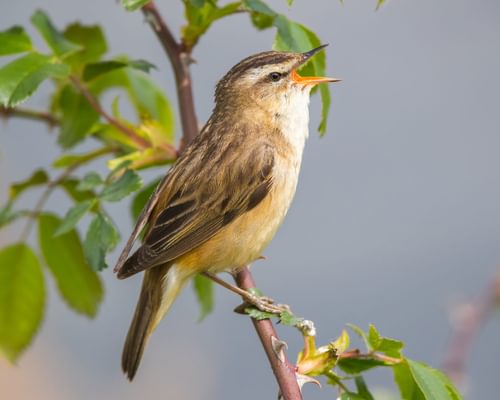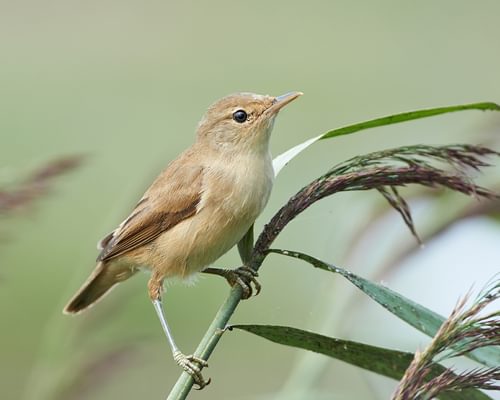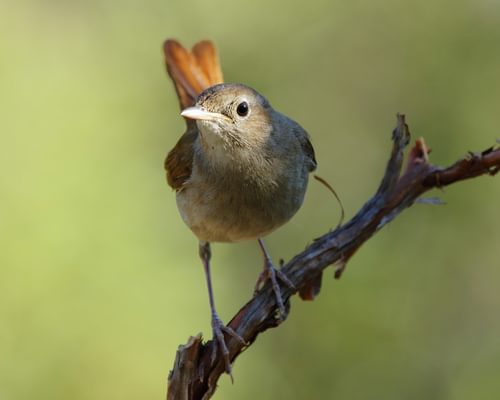Cetti's Warbler
Least ConcernCettia cetti
Visual Identification
Appearance
The Cetti's Warbler is a small, compact bird with a rounded head and short, broad wings. Its plumage is predominantly warm brown above and paler buff-grey below, with a distinctive long, rounded tail often held cocked.
Both sexes look alike, and the only methods of distinguishing between the sexes are by observing their behaviour and listening to their song. The bill is dark grey, with pale pink visible on the base of the lower mandible. Legs are a pinkish brown.
Juveniles resemble adults but may appear slightly more rufous. The bird lacks striking or distinctive markings, contributing to its secretive nature.
Size
Length
13cm to 14cm
Wingspan
15cm to 18cm
Weight
13g to 17g
Colours
Males and females have similar plumage
Primary Colour
Brown
Secondary Colour
Buff Grey
Beak Colour
Brown
Leg Colour
Brown
Habitat and Distribution
Habitats
Woodland
Garden
Wetland
Coastal
Urban
Farmland
Grassland
Desert
Tundra
Rainforest
Mountain
Savanna
Distribution
Cetti's Warblers inhabit dense, damp vegetation near water bodies, including reedbeds, willow scrub, and overgrown ditches. They are found across southern and central Europe and parts of North Africa and extend eastward into Central Asia.
In the UK, they have expanded their range northward since the 1970s, benefiting from milder winters. They are now established breeders in southern and eastern England, with some birds pushing further north and west.
UK spots where sightings have been regularly reported include Radipole Lake and Lodmoor in Dorset, Exminster Marshes in Devon, Marazion Marsh in Cornwall, and Strumpshaw Fen in Norfolk. The species is rarely found inland, and reports north of The Wash and Morecambe Bay are unusual.
Elevation Range
Up to 1,450 meters
Climate zones
Temperate, Mediterranean
Distribution Map
This map gives you a rough idea of where you might spot a Cetti's Warbler. The coloured areas show countries where these birds have been seen.
A few things to keep in mind:
- Birds might not be everywhere in the coloured areas, for example, they may be present around the coast of that country
- Where birds live can change with seasons and available food
- This map is quite simple - it doesn't show exact locations
We're working on making our maps even better! Soon, we hope to show you:
- More detailed maps for bigger countries, including state and region
- How birds move around during different seasons
Distribution by Region
Behaviour and Ecology
Bird Attributes
This feature is in beta. We'd love your feedback to improve it!
Share your thoughtsBird Attributes Explained
Our bird attributes system rates various aspects of a bird's capabilities on a scale of 0-100, based on data from field observations, scientific studies, and expert knowledge.
Attribute Categories:
- Agility: Manoeuvrability, speed, and grace in flight or movement.
- Strength: Physical power, often correlating with size and hunting abilities.
- Adaptability: Ability to thrive in various environments or changing conditions.
- Aggressiveness: Territorial behaviour and assertiveness, particularly during breeding seasons.
- Endurance: Stamina, often seen in migration patterns or foraging behaviours.
Understanding the Ratings:
- 0-20: Very Low
- 21-40: Low
- 41-60: Average
- 61-80: High
- 81-100: Very High
Remember, these attributes are relative to other bird species and don't necessarily indicate superiority.
Hover over the icon next to each attribute for more information.
Tap the icon next to each attribute for more information.
Agility
Reflects the bird's manoeuvrability, speed, and grace in flight or movement.
The Cetti's Warbler displays remarkable agility, moving with quick, mouse-like movements through dense vegetation. Its ability to navigate complex habitats and make sudden, explosive vocalisations suggests high manoeuvrability and bodily control.
Strength
Indicates the bird's physical power, often correlating with size and hunting abilities.
As a small passerine weighing only 13-17 grams, the Cetti's Warbler has limited physical strength. However, its ability to survive in various climates and build sturdy nests indicates a degree of robustness despite its size.
Adaptability
Represents the bird's ability to thrive in various environments or changing conditions.
The Cetti's Warbler demonstrates exceptional adaptability. Its successful range expansion northward in response to climate change, ability to thrive in diverse wetland habitats, and capacity to survive temperatures as low as -15°C showcase its remarkable adaptive capabilities.
Aggressiveness
Measures the bird's territorial behaviour and assertiveness, particularly during breeding seasons.
While not overtly aggressive, male Cetti's Warblers exhibit territorial behaviour during breeding season, delivering loud, distinctive songs to defend their space. Their polygynous mating system also suggests a degree of competitive behaviour.
Endurance
Reflects the bird's stamina, often seen in migration patterns or foraging behaviours.
Despite its small size, the Cetti's Warbler shows impressive endurance. Its ability to survive harsh winters, engage in partial migration, and maintain year-round vocalisation indicates substantial stamina. The bird's capacity to raise multiple broods in a season further supports its endurance rating.
Diet
Cetti's Warblers are primarily insectivorous, feeding on various small invertebrates. The most commonly consumed prey include damselflies, aphids, moths and their larvae, earthworms, beetles, flies, and molluscs.
They forage actively in dense vegetation, picking insects and spiders from leaves and branches. During autumn and winter, when insect availability is lower, they may supplement their diet with small berries and seeds.
Behaviour
Cetti's Warblers are notoriously skulking birds. They prefer to remain hidden in dense undergrowth. They move through vegetation with quick, mouse-like movements and rarely fly in open spaces.
Despite their secretive nature, males become conspicuous during the breeding season, perching briefly in the open to deliver their loud, distinctive song.
Vocalisation
The Cetti's Warbler's song is unmistakable - a sudden, explosive burst of notes often described as "cetti-cetti-cetti" or "plink-plink-plink-plink". This loud, abrupt call seems disproportionate to the bird's size, often startling unsuspecting listeners.
Both males and females sing year-round, although males are more vocal, with increased frequency during breeding season.
Nesting & Breeding
Breeding season for Cetti's Warblers typically begins in April. Males establish territories and attract females with their loud, distinctive song. They are often polygynous, with a male potentially mating with multiple females.
The nest is a deep cup made of grass, leaves, and plant fibres, usually well-hidden in dense vegetation near the ground. Females lay 3-5 reddish-brown eggs, which are incubated for about 16-17 days.
Both parents feed the nestlings, which fledge after 14-16 days. Cetti's Warblers often raise two broods per season, with the male continuing to sing and potentially attracting new mates while the first brood is being raised.
Lifespan
The Cetti's Warbler typically lives for 2 years, with a maximum recorded lifespan of 9.3 years.
Like all birds, lifespan can be affected by factors including predation, habitat quality, disease, and access to food sources.
Conservation and Status
Global Conservation Status
While currently listed as Least Concern, Cetti's Warblers face threats from habitat loss and degradation, particularly the draining of wetlands.
Climate change is influencing their distribution, with populations expanding northward in Europe. Conservation efforts focus on protecting and managing suitable wetland habitats.
Birdwatching Tips
- Listen for the distinctive, explosive song, especially in the early morning or evening
- Look for movement in dense vegetation near water bodies
- Be patient and still; the bird may eventually show itself briefly
- In the UK, focus on wetland reserves and reed beds
Additional Information
Quick Facts
Other names:
Cetti's Bush Warbler
Family:
CettiidaePredators
Did You Know?
- Cetti's Warblers are named after the 18th-century Italian zoologist Francesco Cetti.
- They are among the few European passerines with ten tail feathers instead of the usual 12.
- Despite their small size, they can survive temperatures as low as -15°C (5°F).
- Cetti’s is pronounced ‘chettys’ to rhyme with jetties
Was this bird profile helpful?
Your feedback helps us improve our content
Thanks for your feedback!
Your input helps us improve our content.
Community Experience
Community Ratings
No ratings yet - be the first to rate this bird!
Latest Community Reviews
No reviews yet
Sign in to be the first to review
Community Reviews
Create Your Free Account Welcome Back!
Join our community to rate birds and share your experiences. Creating an account is completely free and only takes a minute. Sign in to your account to rate birds and share your experiences with our community.
Your information is secure and will never be shared.
By creating an account, you agree to our Privacy Policy.
Similar Birds
References
- 2 3
website: BirdLife International. 2017. Cettia cetti (amended version of 2016 assessment). The IUCN Red List of Threatened Species 2017: e.T22714445A111073290.
View source - 4
report, 2015: EBCC
- 1
website, 2012: Robinson and Clark, The Online Ringing Report: Bird ringing in Britain & Ireland in 2011
View source


